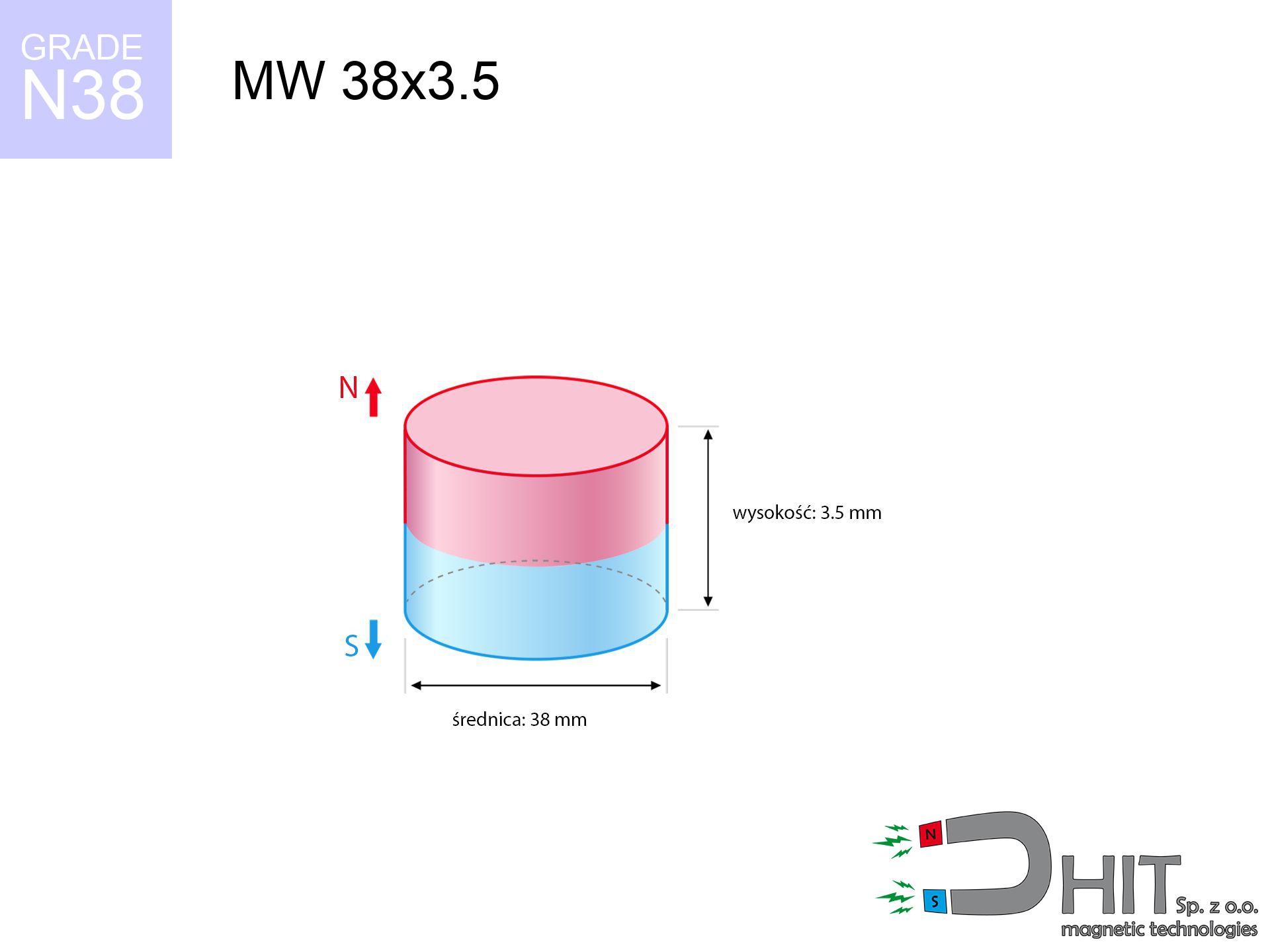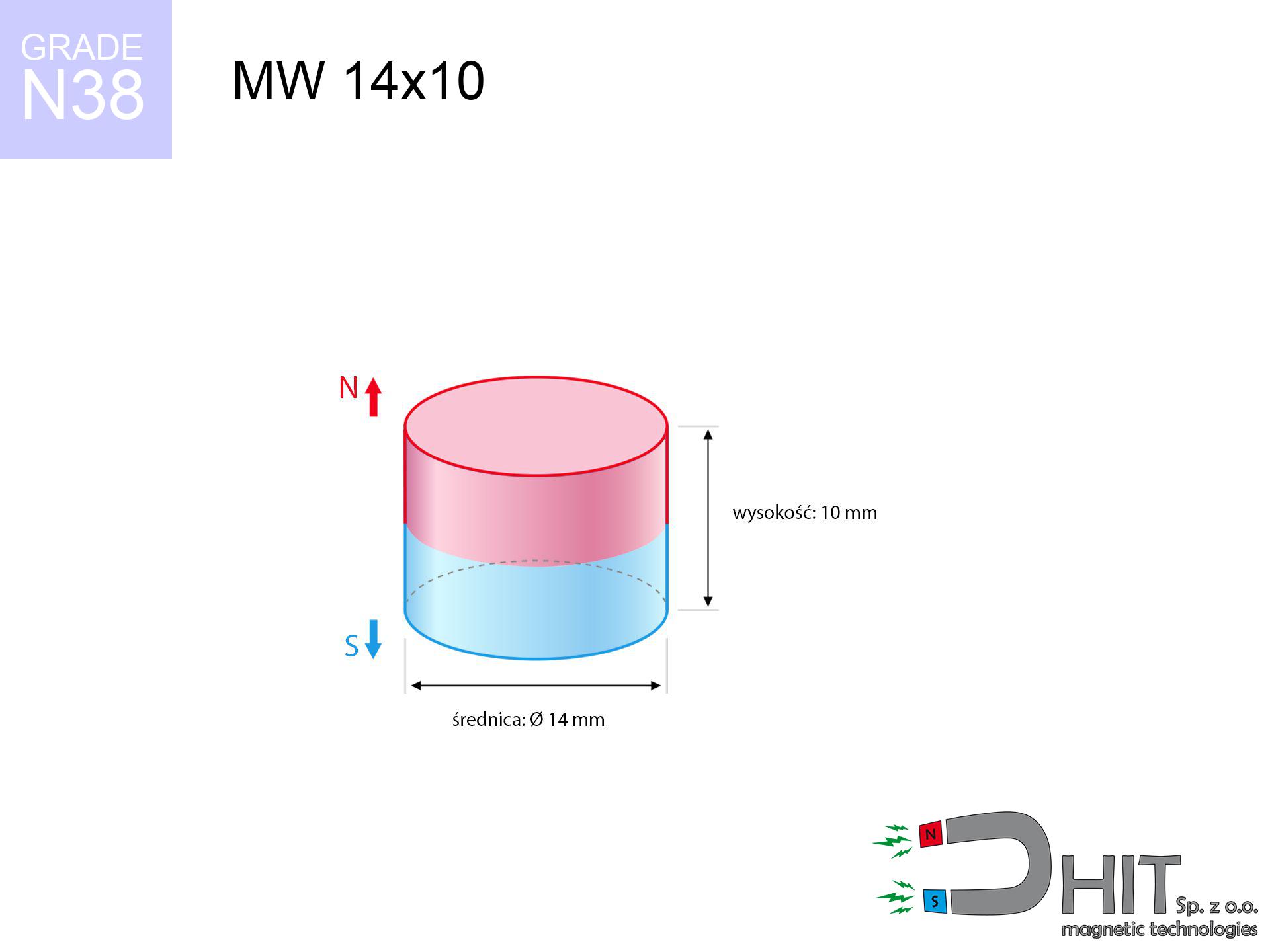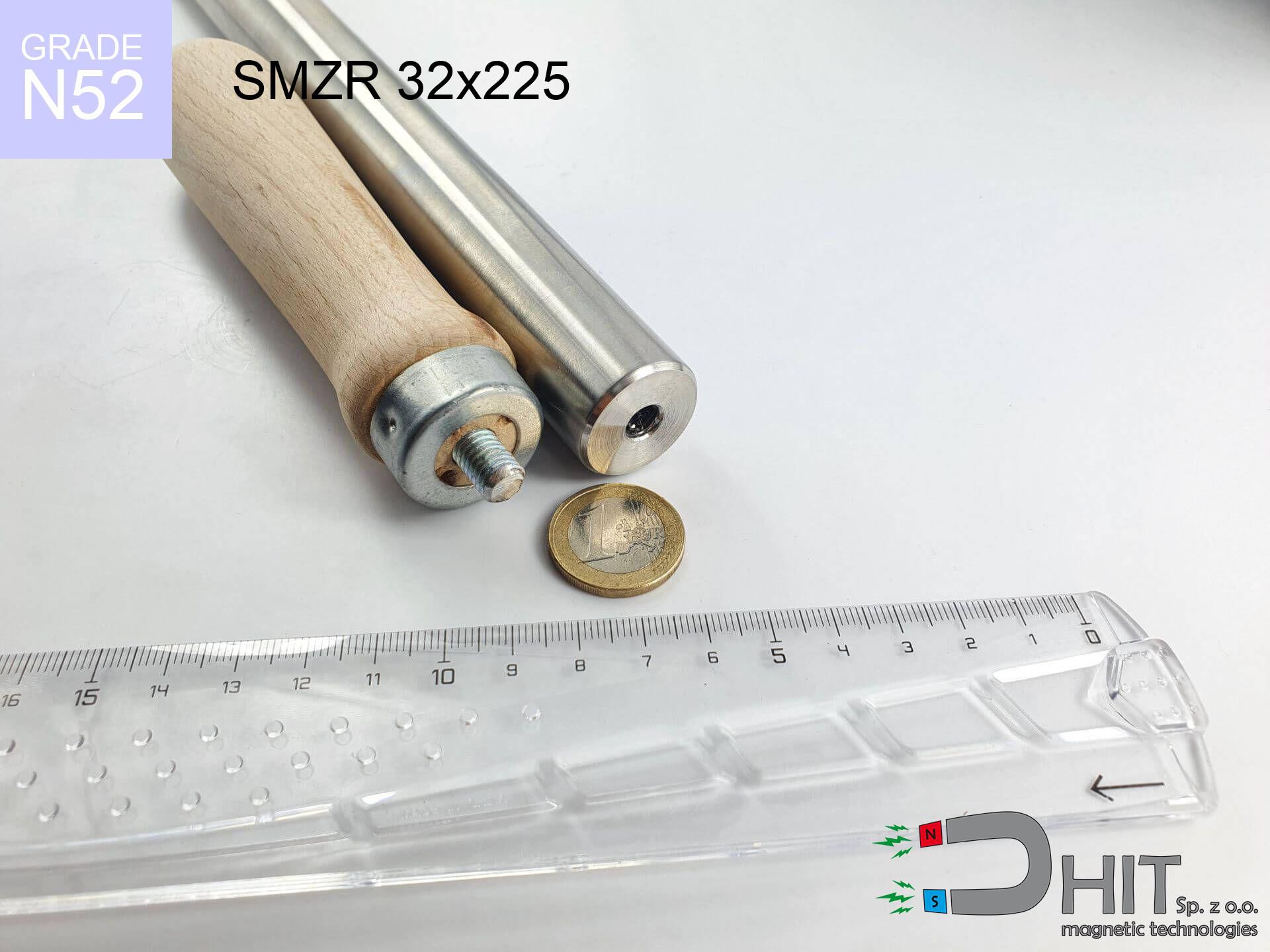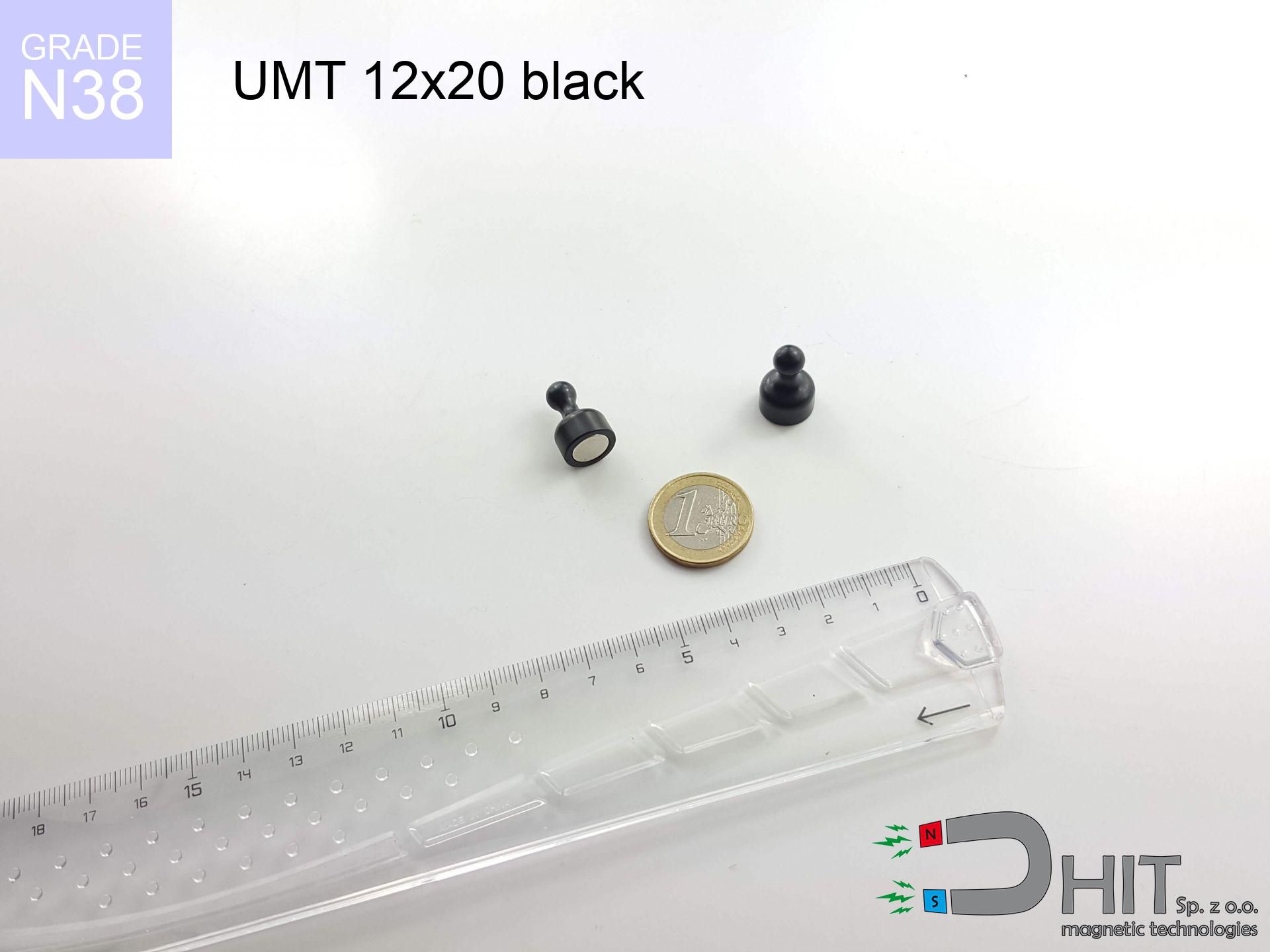MW 38x3.5 / N38 - cylindrical magnet
cylindrical magnet
Catalog no 010062
GTIN/EAN: 5906301810612
Diameter Ø
38 mm [±0,1 mm]
Height
3.5 mm [±0,1 mm]
Weight
29.77 g
Magnetization Direction
↑ axial
Load capacity
5.09 kg / 49.91 N
Magnetic Induction
112.31 mT / 1123 Gs
Coating
[NiCuNi] Nickel
15.83 ZŁ with VAT / pcs + price for transport
12.87 ZŁ net + 23% VAT / pcs
bulk discounts:
Need more?
Call us now
+48 22 499 98 98
if you prefer send us a note via
our online form
the contact form page.
Parameters and appearance of magnets can be analyzed using our
modular calculator.
Orders submitted before 14:00 will be dispatched today!
Product card - MW 38x3.5 / N38 - cylindrical magnet
Specification / characteristics - MW 38x3.5 / N38 - cylindrical magnet
| properties | values |
|---|---|
| Cat. no. | 010062 |
| GTIN/EAN | 5906301810612 |
| Production/Distribution | Dhit sp. z o.o. |
| Country of origin | Poland / China / Germany |
| Customs code | 85059029 |
| Diameter Ø | 38 mm [±0,1 mm] |
| Height | 3.5 mm [±0,1 mm] |
| Weight | 29.77 g |
| Magnetization Direction | ↑ axial |
| Load capacity ~ ? | 5.09 kg / 49.91 N |
| Magnetic Induction ~ ? | 112.31 mT / 1123 Gs |
| Coating | [NiCuNi] Nickel |
| Manufacturing Tolerance | ±0.1 mm |
Magnetic properties of material N38
| properties | values | units |
|---|---|---|
| remenance Br [min. - max.] ? | 12.2-12.6 | kGs |
| remenance Br [min. - max.] ? | 1220-1260 | mT |
| coercivity bHc ? | 10.8-11.5 | kOe |
| coercivity bHc ? | 860-915 | kA/m |
| actual internal force iHc | ≥ 12 | kOe |
| actual internal force iHc | ≥ 955 | kA/m |
| energy density [min. - max.] ? | 36-38 | BH max MGOe |
| energy density [min. - max.] ? | 287-303 | BH max KJ/m |
| max. temperature ? | ≤ 80 | °C |
Physical properties of sintered neodymium magnets Nd2Fe14B at 20°C
| properties | values | units |
|---|---|---|
| Vickers hardness | ≥550 | Hv |
| Density | ≥7.4 | g/cm3 |
| Curie Temperature TC | 312 - 380 | °C |
| Curie Temperature TF | 593 - 716 | °F |
| Specific resistance | 150 | μΩ⋅cm |
| Bending strength | 250 | MPa |
| Compressive strength | 1000~1100 | MPa |
| Thermal expansion parallel (∥) to orientation (M) | (3-4) x 10-6 | °C-1 |
| Thermal expansion perpendicular (⊥) to orientation (M) | -(1-3) x 10-6 | °C-1 |
| Young's modulus | 1.7 x 104 | kg/mm² |
Physical analysis of the product - technical parameters
The following data are the outcome of a physical simulation. Values were calculated on algorithms for the material Nd2Fe14B. Actual parameters might slightly differ from theoretical values. Treat these data as a preliminary roadmap during assembly planning.
Table 1: Static pull force (pull vs gap) - characteristics
MW 38x3.5 / N38
| Distance (mm) | Induction (Gauss) / mT | Pull Force (kg) | Risk Status |
|---|---|---|---|
| 0 mm |
1123 Gs
112.3 mT
|
5.09 kg / 5090.0 g
49.9 N
|
strong |
| 1 mm |
1103 Gs
110.3 mT
|
4.91 kg / 4910.1 g
48.2 N
|
strong |
| 2 mm |
1075 Gs
107.5 mT
|
4.66 kg / 4663.0 g
45.7 N
|
strong |
| 3 mm |
1040 Gs
104.0 mT
|
4.36 kg / 4364.2 g
42.8 N
|
strong |
| 5 mm |
954 Gs
95.4 mT
|
3.67 kg / 3673.1 g
36.0 N
|
strong |
| 10 mm |
703 Gs
70.3 mT
|
2.00 kg / 1997.1 g
19.6 N
|
safe |
| 15 mm |
483 Gs
48.3 mT
|
0.94 kg / 943.2 g
9.3 N
|
safe |
| 20 mm |
326 Gs
32.6 mT
|
0.43 kg / 429.7 g
4.2 N
|
safe |
| 30 mm |
155 Gs
15.5 mT
|
0.10 kg / 97.1 g
1.0 N
|
safe |
| 50 mm |
47 Gs
4.7 mT
|
0.01 kg / 8.9 g
0.1 N
|
safe |
Table 2: Slippage hold (wall)
MW 38x3.5 / N38
| Distance (mm) | Friction coefficient | Pull Force (kg) |
|---|---|---|
| 0 mm | Stal (~0.2) |
1.02 kg / 1018.0 g
10.0 N
|
| 1 mm | Stal (~0.2) |
0.98 kg / 982.0 g
9.6 N
|
| 2 mm | Stal (~0.2) |
0.93 kg / 932.0 g
9.1 N
|
| 3 mm | Stal (~0.2) |
0.87 kg / 872.0 g
8.6 N
|
| 5 mm | Stal (~0.2) |
0.73 kg / 734.0 g
7.2 N
|
| 10 mm | Stal (~0.2) |
0.40 kg / 400.0 g
3.9 N
|
| 15 mm | Stal (~0.2) |
0.19 kg / 188.0 g
1.8 N
|
| 20 mm | Stal (~0.2) |
0.09 kg / 86.0 g
0.8 N
|
| 30 mm | Stal (~0.2) |
0.02 kg / 20.0 g
0.2 N
|
| 50 mm | Stal (~0.2) |
0.00 kg / 2.0 g
0.0 N
|
Table 3: Vertical assembly (shearing) - vertical pull
MW 38x3.5 / N38
| Surface type | Friction coefficient / % Mocy | Max load (kg) |
|---|---|---|
| Raw steel |
µ = 0.3
30% Nominalnej Siły
|
1.53 kg / 1527.0 g
15.0 N
|
| Painted steel (standard) |
µ = 0.2
20% Nominalnej Siły
|
1.02 kg / 1018.0 g
10.0 N
|
| Oily/slippery steel |
µ = 0.1
10% Nominalnej Siły
|
0.51 kg / 509.0 g
5.0 N
|
| Magnet with anti-slip rubber |
µ = 0.5
50% Nominalnej Siły
|
2.55 kg / 2545.0 g
25.0 N
|
Table 4: Material efficiency (substrate influence) - power losses
MW 38x3.5 / N38
| Steel thickness (mm) | % power | Real pull force (kg) |
|---|---|---|
| 0.5 mm |
|
0.51 kg / 509.0 g
5.0 N
|
| 1 mm |
|
1.27 kg / 1272.5 g
12.5 N
|
| 2 mm |
|
2.55 kg / 2545.0 g
25.0 N
|
| 5 mm |
|
5.09 kg / 5090.0 g
49.9 N
|
| 10 mm |
|
5.09 kg / 5090.0 g
49.9 N
|
Table 5: Thermal resistance (stability) - thermal limit
MW 38x3.5 / N38
| Ambient temp. (°C) | Power loss | Remaining pull | Status |
|---|---|---|---|
| 20 °C | 0.0% |
5.09 kg / 5090.0 g
49.9 N
|
OK |
| 40 °C | -2.2% |
4.98 kg / 4978.0 g
48.8 N
|
OK |
| 60 °C | -4.4% |
4.87 kg / 4866.0 g
47.7 N
|
|
| 80 °C | -6.6% |
4.75 kg / 4754.1 g
46.6 N
|
|
| 100 °C | -28.8% |
3.62 kg / 3624.1 g
35.6 N
|
Table 6: Magnet-Magnet interaction (repulsion) - field range
MW 38x3.5 / N38
| Gap (mm) | Attraction (kg) (N-S) | Repulsion (kg) (N-N) |
|---|---|---|
| 0 mm |
8.82 kg / 8818 g
86.5 N
2 143 Gs
|
N/A |
| 1 mm |
8.68 kg / 8679 g
85.1 N
2 228 Gs
|
7.81 kg / 7811 g
76.6 N
~0 Gs
|
| 2 mm |
8.51 kg / 8507 g
83.5 N
2 206 Gs
|
7.66 kg / 7656 g
75.1 N
~0 Gs
|
| 3 mm |
8.31 kg / 8306 g
81.5 N
2 180 Gs
|
7.47 kg / 7475 g
73.3 N
~0 Gs
|
| 5 mm |
7.83 kg / 7829 g
76.8 N
2 116 Gs
|
7.05 kg / 7046 g
69.1 N
~0 Gs
|
| 10 mm |
6.36 kg / 6364 g
62.4 N
1 908 Gs
|
5.73 kg / 5727 g
56.2 N
~0 Gs
|
| 20 mm |
3.46 kg / 3460 g
33.9 N
1 407 Gs
|
3.11 kg / 3114 g
30.5 N
~0 Gs
|
| 50 mm |
0.35 kg / 346 g
3.4 N
445 Gs
|
0.31 kg / 312 g
3.1 N
~0 Gs
|
Table 7: Hazards (implants) - warnings
MW 38x3.5 / N38
| Object / Device | Limit (Gauss) / mT | Safe distance |
|---|---|---|
| Pacemaker | 5 Gs (0.5 mT) | 11.5 cm |
| Hearing aid | 10 Gs (1.0 mT) | 9.0 cm |
| Timepiece | 20 Gs (2.0 mT) | 7.0 cm |
| Mobile device | 40 Gs (4.0 mT) | 5.5 cm |
| Remote | 50 Gs (5.0 mT) | 5.0 cm |
| Payment card | 400 Gs (40.0 mT) | 2.0 cm |
| HDD hard drive | 600 Gs (60.0 mT) | 1.5 cm |
Table 8: Collisions (kinetic energy) - collision effects
MW 38x3.5 / N38
| Start from (mm) | Speed (km/h) | Energy (J) | Predicted outcome |
|---|---|---|---|
| 10 mm |
16.10 km/h
(4.47 m/s)
|
0.30 J | |
| 30 mm |
23.11 km/h
(6.42 m/s)
|
0.61 J | |
| 50 mm |
29.52 km/h
(8.20 m/s)
|
1.00 J | |
| 100 mm |
41.70 km/h
(11.58 m/s)
|
2.00 J |
Table 9: Coating parameters (durability)
MW 38x3.5 / N38
| Technical parameter | Value / Description |
|---|---|
| Coating type | [NiCuNi] Nickel |
| Layer structure | Nickel - Copper - Nickel |
| Layer thickness | 10-20 µm |
| Salt spray test (SST) ? | 24 h |
| Recommended environment | Indoors only (dry) |
Table 10: Construction data (Flux)
MW 38x3.5 / N38
| Parameter | Value | SI Unit / Description |
|---|---|---|
| Magnetic Flux | 17 022 Mx | 170.2 µWb |
| Pc Coefficient | 0.14 | Low (Flat) |
Table 11: Hydrostatics and buoyancy
MW 38x3.5 / N38
| Environment | Effective steel pull | Effect |
|---|---|---|
| Air (land) | 5.09 kg | Standard |
| Water (riverbed) |
5.83 kg
(+0.74 kg Buoyancy gain)
|
+14.5% |
1. Shear force
*Warning: On a vertical wall, the magnet retains just ~20% of its nominal pull.
2. Plate thickness effect
*Thin metal sheet (e.g. computer case) significantly limits the holding force.
3. Power loss vs temp
*For N38 grade, the safety limit is 80°C.
4. Demagnetization curve and operating point (B-H)
chart generated for the permeance coefficient Pc (Permeance Coefficient) = 0.14
The chart above illustrates the magnetic characteristics of the material within the second quadrant of the hysteresis loop. The solid red line represents the demagnetization curve (material potential), while the dashed blue line is the load line based on the magnet's geometry. The Pc (Permeance Coefficient), also known as the load line slope, is a dimensionless value that describes the relationship between the magnet's shape and its magnetic stability. The intersection of these two lines (the black dot) is the operating point — it determines the actual magnetic flux density generated by the magnet in this specific configuration. A higher Pc value means the magnet is more 'slender' (tall relative to its area), resulting in a higher operating point and better resistance to irreversible demagnetization caused by external fields or temperature. A value of 0.42 is relatively low (typical for flat magnets), meaning the operating point is closer to the 'knee' of the curve — caution is advised when operating at temperatures near the maximum limit to avoid strength loss.
Elemental analysis
| iron (Fe) | 64% – 68% |
| neodymium (Nd) | 29% – 32% |
| boron (B) | 1.1% – 1.2% |
| dysprosium (Dy) | 0.5% – 2.0% |
| coating (Ni-Cu-Ni) | < 0.05% |
Sustainability
| recyclability (EoL) | 100% |
| recycled raw materials | ~10% (pre-cons) |
| carbon footprint | low / zredukowany |
| waste code (EWC) | 16 02 16 |
See more products
Strengths and weaknesses of rare earth magnets.
Strengths
- They do not lose magnetism, even during approximately ten years – the decrease in lifting capacity is only ~1% (based on measurements),
- They possess excellent resistance to magnetism drop when exposed to external magnetic sources,
- The use of an shiny layer of noble metals (nickel, gold, silver) causes the element to present itself better,
- Neodymium magnets achieve maximum magnetic induction on a small area, which ensures high operational effectiveness,
- Through (appropriate) combination of ingredients, they can achieve high thermal resistance, enabling action at temperatures reaching 230°C and above...
- Thanks to freedom in shaping and the capacity to customize to unusual requirements,
- Huge importance in advanced technology sectors – they serve a role in magnetic memories, brushless drives, precision medical tools, also industrial machines.
- Thanks to concentrated force, small magnets offer high operating force, in miniature format,
Disadvantages
- To avoid cracks under impact, we recommend using special steel housings. Such a solution secures the magnet and simultaneously improves its durability.
- Neodymium magnets lose strength when exposed to high temperatures. After reaching 80°C, many of them experience permanent weakening of strength (a factor is the shape and dimensions of the magnet). We offer magnets specially adapted to work at temperatures up to 230°C marked [AH], which are extremely resistant to heat
- When exposed to humidity, magnets start to rust. For applications outside, it is recommended to use protective magnets, such as magnets in rubber or plastics, which secure oxidation and corrosion.
- We recommend a housing - magnetic holder, due to difficulties in realizing threads inside the magnet and complicated shapes.
- Possible danger related to microscopic parts of magnets can be dangerous, when accidentally swallowed, which becomes key in the context of child safety. Furthermore, tiny parts of these magnets are able to be problematic in diagnostics medical when they are in the body.
- High unit price – neodymium magnets cost more than other types of magnets (e.g. ferrite), which hinders application in large quantities
Lifting parameters
Highest magnetic holding force – what affects it?
- with the application of a sheet made of special test steel, guaranteeing full magnetic saturation
- with a cross-section no less than 10 mm
- characterized by smoothness
- under conditions of no distance (surface-to-surface)
- during pulling in a direction vertical to the mounting surface
- in temp. approx. 20°C
Determinants of practical lifting force of a magnet
- Air gap (between the magnet and the metal), because even a very small clearance (e.g. 0.5 mm) can cause a reduction in lifting capacity by up to 50% (this also applies to varnish, corrosion or dirt).
- Pull-off angle – remember that the magnet has greatest strength perpendicularly. Under sliding down, the capacity drops significantly, often to levels of 20-30% of the nominal value.
- Substrate thickness – to utilize 100% power, the steel must be sufficiently thick. Thin sheet restricts the attraction force (the magnet "punches through" it).
- Material type – the best choice is high-permeability steel. Cast iron may attract less.
- Plate texture – smooth surfaces guarantee perfect abutment, which increases force. Uneven metal reduce efficiency.
- Thermal factor – high temperature reduces magnetic field. Too high temperature can permanently damage the magnet.
Lifting capacity testing was conducted on a smooth plate of optimal thickness, under perpendicular forces, however under parallel forces the lifting capacity is smaller. Additionally, even a minimal clearance between the magnet’s surface and the plate decreases the lifting capacity.
H&S for magnets
Physical harm
Big blocks can crush fingers instantly. Do not put your hand betwixt two strong magnets.
Magnets are brittle
Protect your eyes. Magnets can explode upon violent connection, launching shards into the air. We recommend safety glasses.
Fire risk
Drilling and cutting of NdFeB material poses a fire risk. Magnetic powder oxidizes rapidly with oxygen and is difficult to extinguish.
Phone sensors
Remember: neodymium magnets generate a field that disrupts precision electronics. Maintain a safe distance from your phone, tablet, and navigation systems.
Data carriers
Do not bring magnets near a purse, laptop, or TV. The magnetic field can irreversibly ruin these devices and wipe information from cards.
Heat sensitivity
Control the heat. Heating the magnet above 80 degrees Celsius will destroy its magnetic structure and strength.
Metal Allergy
Warning for allergy sufferers: The nickel-copper-nickel coating consists of nickel. If an allergic reaction appears, immediately stop handling magnets and wear gloves.
Life threat
Warning for patients: Powerful magnets affect electronics. Keep at least 30 cm distance or ask another person to work with the magnets.
Product not for children
Product intended for adults. Tiny parts pose a choking risk, leading to intestinal necrosis. Store out of reach of children and animals.
Conscious usage
Handle magnets consciously. Their powerful strength can shock even professionals. Plan your moves and do not underestimate their force.









